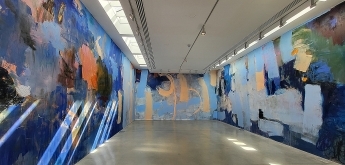Is SITE-SPECIFIC art really such a new idea
RECENTLY, WE HAVE viewed two exhibitions, one in Cambridge and the other in Dulwich (South London), which contain site specific works. The website of New York’s Guggenheim Museum (www.guggenheim.org/artwork/movement/s...) defines site specific art as follows:
“Site-specific or Environmental art refers to an artist’s intervention in a specific locale, creating a work that is integrated with its surroundings and that explores its relationship to the topography of its locale, whether indoors or out, urban, desert, marine, or otherwise … No matter which approach an artist takes, Site-specific art is meant to become part of its locale, and to restructure the viewer’s conceptual and perceptual experience of that locale through the artist’s intervention.”
It seems that site-specific art is the name given to a relatively recent artistic trend or movement.

By Megan Rooney
In Cambridge’s Kettle’s Yard, we saw a room whose walls were entirely covered by paintings created by the artist Megan Rooney. She spent several days painting on the walls. When the exhibition is over (on the 6th of October 2024), the walls will be whitewashed, and her site-specific creation made especially for the room will disappear. At Dulwich Picture Gallery, there is a room whose walls have been decorated by the Japanese artist Yoshida Ayomi. Her beautiful evocation of cherry blossom was made specially for the room in which it can be seen. Her site-specific work will be removed when the exhibition is over on the 3rd of November 2024. These two artworks, like those of the artist Christo Vladimirov Javacheff (1935–2020), who temporarily covered buildings with sheets of various materials, are classed as site-specific. Currently, it seems to me that site-specific artworks are usually temporary in nature.
Michelangelo covered the walls and ceilings of Rome’s Sistine Chapel with paintings. Likewise, the ceiling in the Residenz, a palace in Würzburg, were covered by paintings created by Giovanni Battista Tiepolo and his sons specially for the room. Should these examples and many others like them be considered ‘site-specific’ art, or is the term only to be applied to creations of artists made during the 20th and 21st centuries? Probably not, because those who commissioned frescoes and murals for rooms many centuries ago, usually hoped that the artworks would outlast them and their creators. The artists who have made site specific art currently and in the recent past do not always expect them to last for as long as those made several centuries ago.



